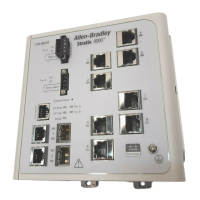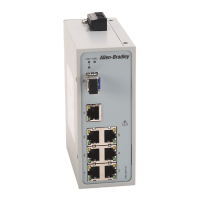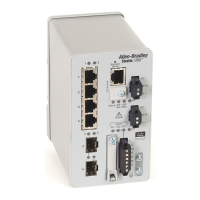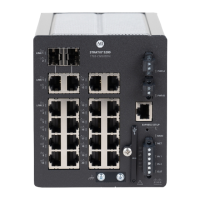80 Rockwell Automation Publication 1783-UM003G-EN-P - December 2012
Chapter 3 Manage the Switch via the Device Manager Web Interface
By default, PTP is in forwarding mode which means the switch doesn't
take an active role in PTP communications.
4. Check the synchronization state on the switch port.
The switch expansion modules do not support PTP modes other than
forwarding. If boundary or transparent modes are enabled on the base
switch, PTP devices cannot be used on the expansion module ports.
Example: If a controller is talking to a drive with PTP active and PTP is
enabled on the switch, both ports must be connected to the base
switch.In End-to-end Transparent mode, all switch ports are PTP-enabled.
In boundary mode, one or more switch ports can be PTP-enabled. You can
enable or disable PTP on a per-port basis.
Synchronization State
In This Mode The Switch Port Can Be Description
Boundary Listening The switch port is waiting while a parent or Grandmaster clock is selected.
Pre-master The switch port is transitioning to change to Master state.
Master The switch is acting as a parent clock to the devices connected to that switch
port.
Passive The switch has detected a redundant path to a parent or Grandmaster clock.
For example, two different switch ports claim the same parent or Grandmaster
clock. To prevent a loop in the network, one of the ports changes to Passive
state.
Uncalibrated The switch port cannot synchronize with the parent or Grandmaster clock.
Slave The switch port is connected to and synchronizing with the parent or
Grandmaster clock.
Faulty PTP is not operating properly on that switch port.
Disabled PTP is not enabled on the switch port.
End-to-End Transparent Not Faulty The switch port is operating properly.
Faulty The switch port is not operating properly.
Faulty (PTP is disabled) PTP is not enabled on the switch port.
Forward PTP is not enabled on the switch port.

